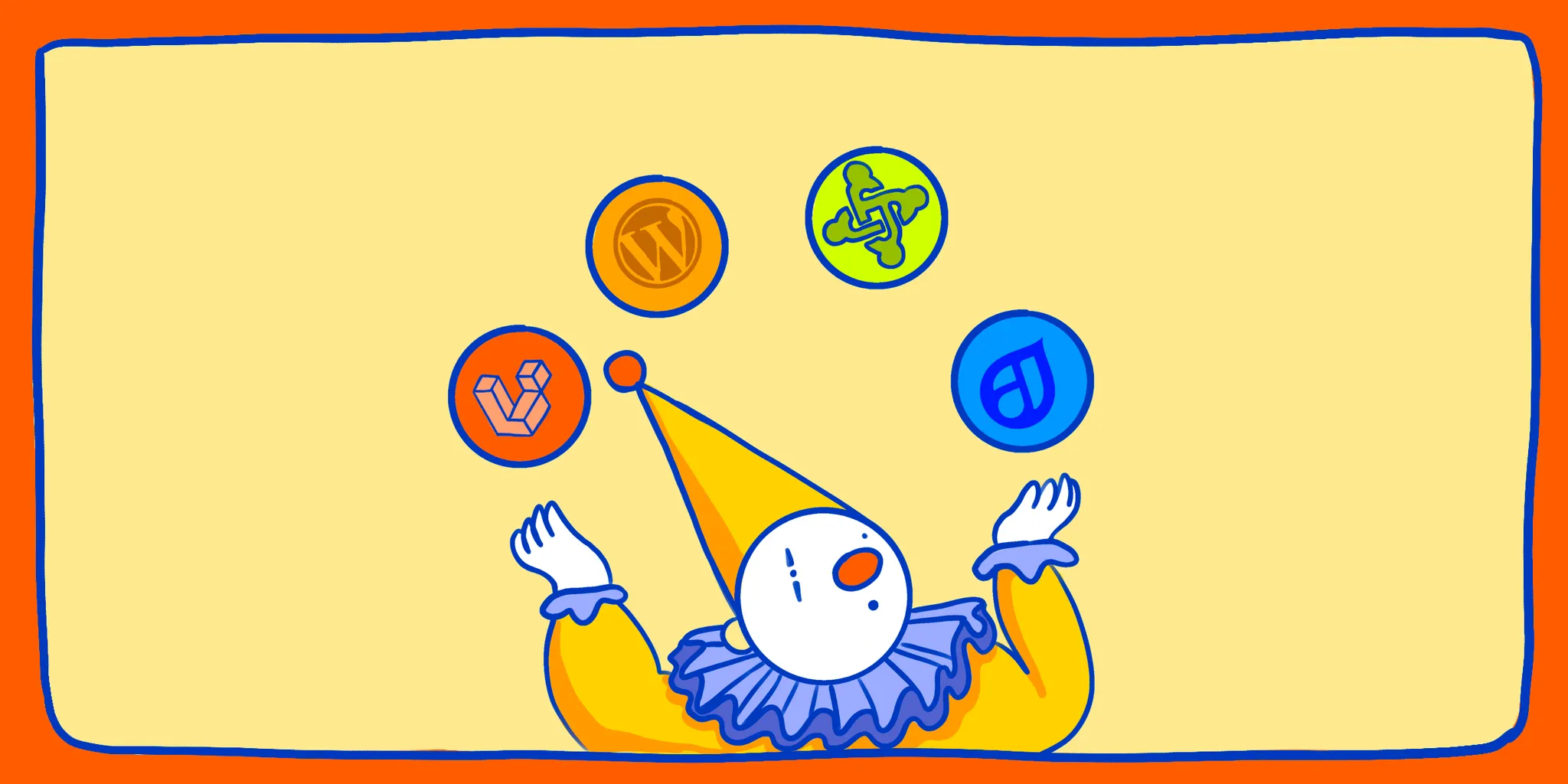Interested in generating passive income? Join our partnership program and receive a commission on each new client referral. Learn more.
7 min read
Laravel vs Template CMS: Which is Better for Your Websites in 2025?
 If you’re planning your website in 2025, the fork in the road is familiar: use a template CMS (WordPress, Joomla, Drupal) and launch quickly, or build a custom Laravel site and invest in a platform tailored to your needs. CMSs dominate the web - WordPress alone powers ~43% of all websites - largely because they’re accessible and quick to ship.
If you’re planning your website in 2025, the fork in the road is familiar: use a template CMS (WordPress, Joomla, Drupal) and launch quickly, or build a custom Laravel site and invest in a platform tailored to your needs. CMSs dominate the web - WordPress alone powers ~43% of all websites - largely because they’re accessible and quick to ship.
But as your requirements move beyond a brochure (complex content, performance under load, security, multilingual SEO, deeper integrations, the plugin-stack model of a template CMS often begins to work against you. Plugins conflict, Core Web Vitals sag, and security becomes a patchwork of updates. Laravel takes the opposite approach: instead of bolting features on, you design the platform around the business.
What is a “Template CMS” - Really?

A template CMS is a pre-built content management system that provides an admin UI, themes, and an ecosystem of plugins so non-technical teams can publish quickly. The appeal is obvious: pick a theme, install a few plugins, and you’re live. For straightforward use cases, this is brilliant.
But the convenience comes with trade-offs: themes bring heavy code you may not need, plugins pile up to cover basics like SEO and multilingual content, and every new dependency adds potential conflicts or vulnerabilities. Over time, this can erode site performance, SEO, and security.
Pros of a template CMS:
- Fast to launch with minimal development
- Low upfront cost
- Accessible for non-technical users
- Huge plugin/theme ecosystem
Cons of a template CMS:
- Performance drags as plugins accumulate
- Frequent plugin/theme vulnerabilities
- Limited flexibility for complex workflows
- SEO reliant on plugins rather than architecture
What is Laravel?
Laravel is a modern PHP framework for building custom websites and applications. Instead of adapting to a theme and plugins, developers design your site’s architecture from the ground up, modeling your workflows, content structures, and integrations.
Pros of Laravel:
- Fully customizable and scalable
- Optimized for performance (caching, queues, headless setups)
- Enterprise-level security by default
- SEO baked into the architecture
- Easier to evolve into a web app if needed
Cons of Laravel:
- Higher upfront development cost
- Longer time-to-launch than a CMS
- Requires ongoing developer support
CMS vs Laravel: The differences That Matter in 2025
1) Performance & Core Web Vitals
Core Web Vitals (LCP, INP, CLS) are now critical for search ranking. CMS sites often degrade as plugins and visual builders add render-blocking scripts. Laravel allows performance to be engineered in from the start: tuned queries, built-in caching, and headless rendering (Next/Nuxt) to keep load times fast at scale.
2) Security posture
CMS vulnerabilities overwhelmingly stem from plugins and themes. Laravel provides stronger defaults (CSRF, XSS, SQL injection protection) and a curated package ecosystem, reducing the risk surface significantly.
3) SEO architecture
CMS plugins like Yoast help, but they can’t fix structural flaws. Laravel lets you design clean URL hierarchies, dynamic sitemaps, canonicalization, and schema at the framework level, ensuring your SEO is native, not bolted on.
4) Editorial control
With a CMS, content editors have freedom - sometimes at the expense of site stability. In Laravel builds, Redberry uses Filament CMS + our custom Page Builder plugin to give editors block-based control and live previews while keeping SEO and Core Web Vitals intact.
5) Cost of ownership
CMS tools look cheaper up front, but ongoing plugin management, patching, and performance fixes add up. Laravel requires more initial investment but reduces long-term friction, avoiding the cost of a future rebuild.
Case study: Carfest - When “a Website” Becomes The Business
Carfest set out to create Georgia’s first digital car dealership. At first glance, a CMS could have delivered a simple online catalog. But Carfest needed much more:
- Rich product pages with photos, videos, and detailed specifications
- Built-in trust signals: 1-year warranties, 150+ point condition reports, and 7-day return policies
- Conversion-optimized flows for buying, selling, and test-driving vehicles
- Fast, reliable performance that wouldn’t degrade under high traffic
By building on Laravel, we created a platform designed around these specific business needs instead of forcing plugins to approximate them. Within a year, Carfest was operating at a $10 million annual run rate, proving that the right web architecture can directly drive commercial outcomes.
🔗 Explore the project: Carfest case study
When to Choose a Template CMS (and Feel Good About It)
A CMS is still the best choice if your needs are modest and likely to remain that way:
- Simple brochure sites (5–10 static pages)
- Short-lived campaign microsites
- Budget-constrained early projects where speed matters more than scale
In these cases, a CMS will get you online quickly, with a UI that non-technical staff can manage confidently.
When to Choose Laravel (and Why It Pays Off)
Laravel becomes the smarter option when your site is a business platform rather than a digital flyer:
- You expect growth in scope and complexity (more pages, workflows, integrations)
- You need custom logic (booking, dashboards, gated content)
- You operate in sensitive industries where uptime and security are critical
- You want editorial flexibility without sacrificing performance
- You see the site evolving into a web app or product in the future
Here, Laravel is not “overkill” - it’s insurance that your site can keep pace with the business.
Redberry’s approach to Laravel Website Development
At Redberry, we don’t recommend Laravel by default. We recommend it when it matches the business horizon. When it does, our process is built to deliver fast, safe, and scalable sites:
- Architecture-first planning - we define content models, roles, SEO strategy, and governance before writing code.
- Modern frontends - often headless Next.js/Nuxt builds paired with Laravel APIs for speed and SEO.
- Filament + Page Builder - our open-source plugin gives editors a CMS-like UI for block-based content, live previews, and reusable components.
- Dual-track delivery - design and development move in parallel to reduce time-to-launch.
- Reusable design systems - ensure future updates stay fast, consistent, and on-brand.
🔗 Learn more: Laravel Website Development services
Conclusion
If your website will always remain a static brochure, a CMS is the fastest, cheapest path. But if your site is meant to scale with your business, power complex workflows, or support heavy traffic, Laravel is the foundation that won’t hold you back.
- For simple brochures and short campaigns → Template CMS
- For growth-ready businesses → Laravel
👉 Explore our Laravel Website Development process or check out our Projects to see how the right architecture fuels real-world business outcomes.
Frequently Asked Questions
Is Laravel better than WordPress for SEO?
Yes, for complex or high-traffic websites. WordPress relies on plugins to manage SEO, but they can conflict and bloat performance. Laravel lets SEO be part of the site’s architecture itself: clean URLs, schema, sitemaps, and Core Web Vitals are engineered, not patched. For small sites, WordPress plugins may be enough, but at scale, Laravel is more reliable.
Is Laravel overkill for a small website?
It can be. If you’re only publishing a simple brochure site with no integrations, a CMS will serve you better. But if your business expects to add complex features - like booking, e-commerce, or multi-language support - Laravel prevents you from needing a costly rebuild later.
Can non-technical staff update a Laravel site?
Yes. With the right setup, editors get an experience as easy as WordPress. At Redberry, we use Filament + our Page Builder plugin so marketing teams can add new blocks, update SEO metadata, and preview changes live - all without developer intervention.
What are the long-term costs of CMS vs Laravel?
CMS sites are cheaper up front but can accumulate hidden costs: plugin licenses, performance optimization, patching, and eventually rebuilds. Laravel is more expensive at launch but lowers the total cost of ownership because the codebase stays clean, scalable, and adaptable as needs grow.
Which is more secure: CMS or Laravel?
CMS security depends heavily on plugins and frequent patching. Many reported vulnerabilities in WordPress come from third-party plugins or themes. Laravel provides built-in safeguards (CSRF, XSS, SQL injection protection) and a curated ecosystem, which generally makes it more secure for businesses handling sensitive data.
Do Laravel sites take longer to launch?
Yes. A CMS site can be live in days; a Laravel site typically takes longer because it’s custom-built. But the trade-off is that once live, it’s stable and doesn’t need constant plugin babysitting.
Table of Contents
- What is a “Template CMS” - Really?
- What is Laravel?
- CMS vs Laravel: The differences That Matter in 2025
- Case study: Carfest - When “a Website” Becomes The Business
- When to Choose a Template CMS (and Feel Good About It)
- When to Choose Laravel (and Why It Pays Off)
- Redberry’s approach to Laravel Website Development
- Conclusion
- Frequently Asked Questions

Meet the authors
We are a 200+ people agency and provide product design, software development, and creative growth marketing services to companies ranging from fresh startups to established enterprises. Our work has earned us 100+ international awards, partnerships with Laravel, Vue, Meta, and Google, and the title of Georgia’s agency of the year in 2019 and 2021.




